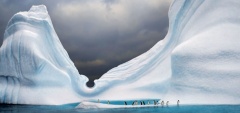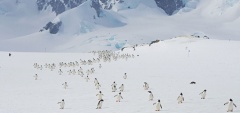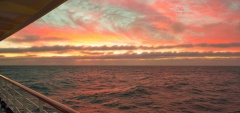A Guide to Antarctica
Arranging a trip to the Antarctic can be a pretty daunting prospect with what seems like endless options, boats, timings, prices and activities. In all reality, it is nowhere near as tricky as you would think!
In this section we have tried to lay out the options for you as simply as possible and from there you can then use the rest of the site to delve further once you have gotten the gist of it all! Alternatively, of course, if you would prefer not to have to try and work it out just give us a call or send us an email and we will be happy to help!
Roughly speaking there are 4 ways to get started as per the below:
ITINERARY
Where it looks to the uninitiated that there are thousands of options to consider for a trip down the Antarctic, there are only, in fact, a couple of main itineraries which have, over the years, been slightly adapted to suit a key market request:
The Antarctic Peninsula – often also known as the “Classic Antarctic” itinerary, this is normally between 10 and 12 nights (depending on the operator who may or may not include accommodation at the start and end of the trip) and involves a 2 day passage across the Drake Passage to the Antarctic Peninsula and the main group of islands called the South Shetland Islands.
From there it is normal to spend 4 or 5 nights cruising along what is one of the most spectacular and varied regions in the Antarctic circle if not, arguably, the world! All cruise companies include morning and afternoon disembarkations that are either “wet” or “dry” and will allow you to explore the many penguin rookeries of the islands and mainland as well as visiting by boat icebergs, and seal colonies.
The general inclusions in the itinerary are the famous Half Moon Bay and Deception Island as well as Livingston Island, Hope Bay and the Antarctic Sound. The trip may also include picturesque Neko Harbor, sheltered Paradise Harbor, the Humpback Whale favored Wilhelmina Bay, the striking Lemaire Channel, the wildlife-filled Penola Channel, or the majestic Neumayer Channel.
It is worth noting that, while there is a huge range of things to see and activities to do, most itineraries will be unique due to the range of weather conditions that are prevalent in this area of the world and so the captain often has to amend the schedule daily.
Crossing the polar circle – essentially a longer version (by a couple of days) of the Classic Antarctic itinerary, the extra couple of days allows the boats to head further to the south along the Peninsula and, therefore, reach the Polar Circle.
The additional distance doesn’t really give you the opportunity of seeing anything different to the Classic itinerary but, by spending longer in the region you will have a higher chance to see all of the main sights as well as being able to tell your friends that you are a polar explorer!
Fly and Cruise – offering abridged versions of the above two itineraries (the Classic and the Polar circle itineraries) this format of cruise has become more and more popular over the last few years as it allows those that either don’t have the time or the inclination to cross the Drake passage a speedier option to visit the Antarctic Peninsula.
The key to the itineraries is that, rather than spending 2 days in each direction getting from South America down to Antarctica, you simply fly from Punta Arenas down to King George Island in the South Shetland Islands where you meet up with your boat and cruise the peninsula.
The main benefits to this type of trip are in the main that you can avoid the tempestuous Drake passage crossing and that you can complete your visit in around 3 days less than by cruising out and back. The main drawback is that you lose, on average, a day of cruising the Antarctic Peninsula and, as with the cruising itineraries, you are at the mercy of the weather for the flights.
The Falklands, South Georgia and the Antarctic Peninsula – far and away the longest of the standard itineraries to Antarctica (from the South American approach) this itinerary spends a good deal of time in the open oceans accessing both the remote Falklands Islands and the even more remote South Georgia and Sandwich Islands, and so is not for those without good sea legs.
On average (there are one or two variations) the itinerary is around 21 days and adds the historical interest of the Falklands and the exceptional wildlife (particularly King Penguin colonies) of South Georgia onto the standard benefits of visiting the Antarctic Peninsula.
With the additional time at sea there are obvious drawbacks such as frequency of these itineraries and the additional costs but, in our opinion, for the penguin colonies of South Georgia alone the addition is worthwhile!
Ross and Weddell Seas – seen as more expeditionary destinations, the Ross and the Weddell Seas tend to be visited by the more hardy of the cruise boats but there are one or two (such as the Ushuaia) that offer cruises to them. The main reasons for heading to these more remote regions is for the fleeting glimpse of the famous Emperor penguin and for fascinating pack ice sculptures.
Please take a look at our itineraries section for more information on each of these >>
TIME OF YEAR
Every time of the sailing season (which runs from late October to the end of March) has its benefits and drawbacks. In a nutshell the below is true although please follow the more reading link below for a more detailed summary. Please note that travel outside of the main months of December and January can reap plenty of rewards in the way of wildlife, availability and prices!
October and November – this is the start of the Antarctic cruise season and so the weather can still be a little unpredictable, often influencing itineraries at the last minute. This being said it is an absolutely superb time to see vast ice structures as the pack ice starts to disperse and to witness the comical goings-on as the myriad penguins start to prepare for another courting season.
December and January – right in the heart of the Antarctic summer these are seen as the busiest and most productive months to head down to the southern polar region with the longest daylight hours and the most animal activity with young penguin chicks and wildlife aplenty.
March – the Antarctic summer draws to a close this can be one of the most magical times of the year to head down to the southern cap with exceptional sunsets and arguably the best sightings of the regions larger aquatic inhabitants in the form of whales.
Please head to the Best time to visit Antarctica section for more information…
TYPE OF TRIP
Of course, the main type of trip to Antarctica is going to involve a cruise ship of some sort at some point along the way but within this remit there are one or two subdivisions that may be worth taking a look at as follows:.
Adventurous – for those that are keen not to just sit back and watch the scenery and wildlife scroll past a window, there are boats and cruise options that offer an array of physical activities. Often these options are possible on boats that also cater to the other categories in this section, but it is always worth mentioning when you start looking at your trip as there are certain boats that offer interesting options such as kayaking and camping amongst the frozen scapes. To illustrate further the following activities are on offer with a variety of ships and land based camps; camping, kayaking, snow-shoeing, mountaineering, snorkelling and diving.
Photography and wildlife - obviously one of the main reasons that many visit the Antarctic, there are certain sailings within the year that have specialist photographers on board who can help you will the many aspects of wildlife photography and photography in this area of the world. In the main the best time of the year fro photography is normally held as being around the end of the sailing season at the end of February and into March as the nights start to draw in.
Luxury - where many of the older boats that head down to these frozen waters were once expeditionary boats that have now been updated and “softened”, there is now a new breed of boats that are offering ultra-luxury for those that are wanting something a little more luxurious.
Please take a look at the ship section for more information.
BUDGET
It is certainly true to say that a trip to the white continent is not the least expensive holiday you may embark upon but, with the extreme conditions, remote locations and limited availability, you will soon realize that the costs are justified!
Depending on the time of year that you are considering (please see the “time of year” section above), the entry level price for heading to the Antarctic region is by looking and the “Antarctic Express” itinerary above which involves a one way flight out to the South Shetland Islands and cruises back. The price for this itinerary starts at approximately $4,700 per person for a 5 night itinerary.
From here the prices tend to jump pretty significantly with the longer spent (or the more flights taken) adding incrementally to the overall costs. The most frequently booked itinerary, the “Classic Antarctica” itinerary, starts at approximately $7,800 per person for the 12 night itinerary, spending 5 nights cruising alongside the Antarctic mainland peninsula.
For further prices, itineraries and dates please take a look at our sailing schedule.
If this all seems too much then please feel free to call us on +44 1525 306 555 or email us to discuss with one of our tailormade consultants!
[block:block=8]



